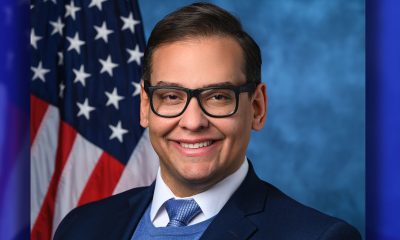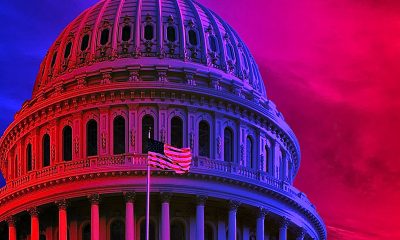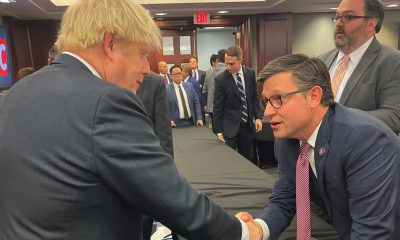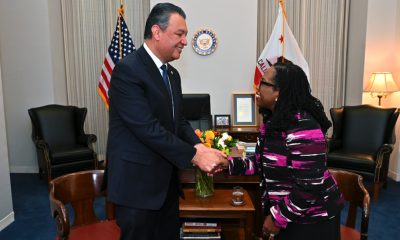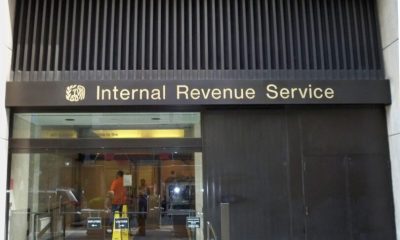Politics
House Scraps Vote on Confederate Flag in Federal Cemeteries

In this June 30, 2015 file photo, a Confederate flag flies at the base of Stone Mountain in Stone Mountain, Ga. (AP Photo/David Goldman, File)
DAVID ESPO, Associated Press
ANDREW TAYLOR, Associated Press
WASHINGTON (AP) — Retreating under pressure, House Republicans scrapped plans for a vote Thursday on allowing the display of Confederate flags at Park Service-run cemeteries after Democrats protested furiously that the banner celebrates a murderous, racist past.
“What exactly is the tradition of the Confederate battle flag that we’re supporting?” Rep. Hakeem Jeffries, D-N.Y. challenged supporters of the proposal, shortly before the GOP leadership announced its decision.
“Is it slavery, rape, kidnap, treason, genocide or all of the above?”
No Republican rose to respond, although some officials privately charged that Democrats had falsely accused GOP lawmakers of racism and said the proposal would merely have written Obama administration policy into law.
Speaker John Boehner, R-Ohio said it was time for “adults here in Congress to actually sit down and have a conversation about how to address the issue.”
Democratic protests aside, the vote had been slated for a politically awkward time — hours after the South Carolina Legislature decided to remove the Confederate flag from a pole on the grounds of the State capitol.
The decision abruptly halted debate on legislation providing funds for the Interior Department and related agencies. But the political significance was more far-reaching than an annual spending measure, marking the latest in a string of developments relating to the Confederate flag in the House.
Earlier in the week, lawmakers decided by voice vote and without controversy to ban the display of the Confederate flag in Park Service-run cemeteries.
But GOP leaders soon became concerned that the overall spending measure might fail — Democrats oppose it because they want more spending and some Republicans were unhappy with the prohibition on the flag.
That led to plans to reconsider the prohibition in a vote hurriedly set for afternoon — and a highly unusual statement by the measure’s chief Republican sponsor after the subsequent decision to reverse course.
Rep. Ken Calvert, R-Calif., and chairman of the panel with jurisdiction over Park Service funding, said the now-abandoned proposal “had been brought to me by Leadership at the request of some southern” GOP lawmakers, and also would have written into law existing National Park Service regulations approved by the Obama administration.
At the same time, he said he regretted not telling Democrats in advance about his plans.
Rather than accept any apology, Democrats attacked at both ends of Pennsylvania Avenue.
“These are these same House Republicans who voted for a party leader who once described himself as, quote, ‘David Duke without the baggage,’ ” said White House spokesman Josh Earnest. He referred to Rep. Steve Scalise, R-La., the third-ranking leader.
For her part, House Democratic Leader Nancy Pelosi offered legislation to remove all state flags containing any portion of the Confederate battle flag from the House side of the Capitol. Republicans prevented a vote on it by referring it to a committee — but Democrats slowed the tally by casting their votes manually instead of through an electronic tally system that is customarily employed.
At the same time, Boehner’s spokesman, Kevin Smith, accused Pelosi of a “cheap political stunt” after the speaker had called for a private talks on the issue. He said the bipartisan talks could potentially address Confederate symbols within the Capitol as well as at parks and cemeteries.
Whatever the political fallout, the now-defunct proposal would have permitted the limited display of the Confederate flag at Park Service-run cemeteries in states that observe a holiday commemorating the Confederacy, and only at the graves of rebels who died in the Civil War.
In line with a Park Service memorandum from 2010, it would have affected 10 graveyards, including four in Tennessee, three in Virginia and one each in Louisiana, Mississippi and Georgia.
Park Service spokeswoman Kathy Kupper said one of the Confederate’s grave was at Andersonville cemetery in Georgia and two each were at Shiloh in Tennessee and Vickburg in Mississippi.
Among the 20,000 graves at the Vicksburg National Memorial park in Mississippi are two that hold the remains of Confederates, according to Ray Hamel, a park ranger at the site. He said both men — one from Texas and one from Arkansas — died in a nearby Union hospital and were mistakenly buried in the U.S. cemetery when it was established in 1866.
Hamel said that on national Memorial Day at the park, volunteers place small a small American flag by the gravesite of each U.S. soldier, and the two Confederate graves are decorated with the national flag of the Confederate States of America, with three wide bars — red, white, red — and a blue canton corner with a circle of 13 white stars.
Ironically, Kupper said nine confederates rest in graves at Gettysburg, Pa. The state does not observe a holiday in memory of the Confederacy.
_____
Eds: AP reporters Erica Werner and Jim Kuhnhenn in Washington and Emily Wagster Pettus in Mississippi contributed to this story
Copyright 2015 The Associated Press. All rights reserved. This material may not be published, broadcast, rewritten or redistributed.
Alameda County
Board of Supervisors Accepts Certification of Signatures, Will Schedule Recall Election May 14
The Alameda Board of Supervisors unanimously accepted the certification of the results of the valid signatures submitted for the recall of District Attorney Pamela Price on Tuesday evening. The Board will set the election date at a special meeting on May 14. Before the meeting, recall proponents and opponents held separate press conferences to plead their cases to the Board and residents of Alameda County.
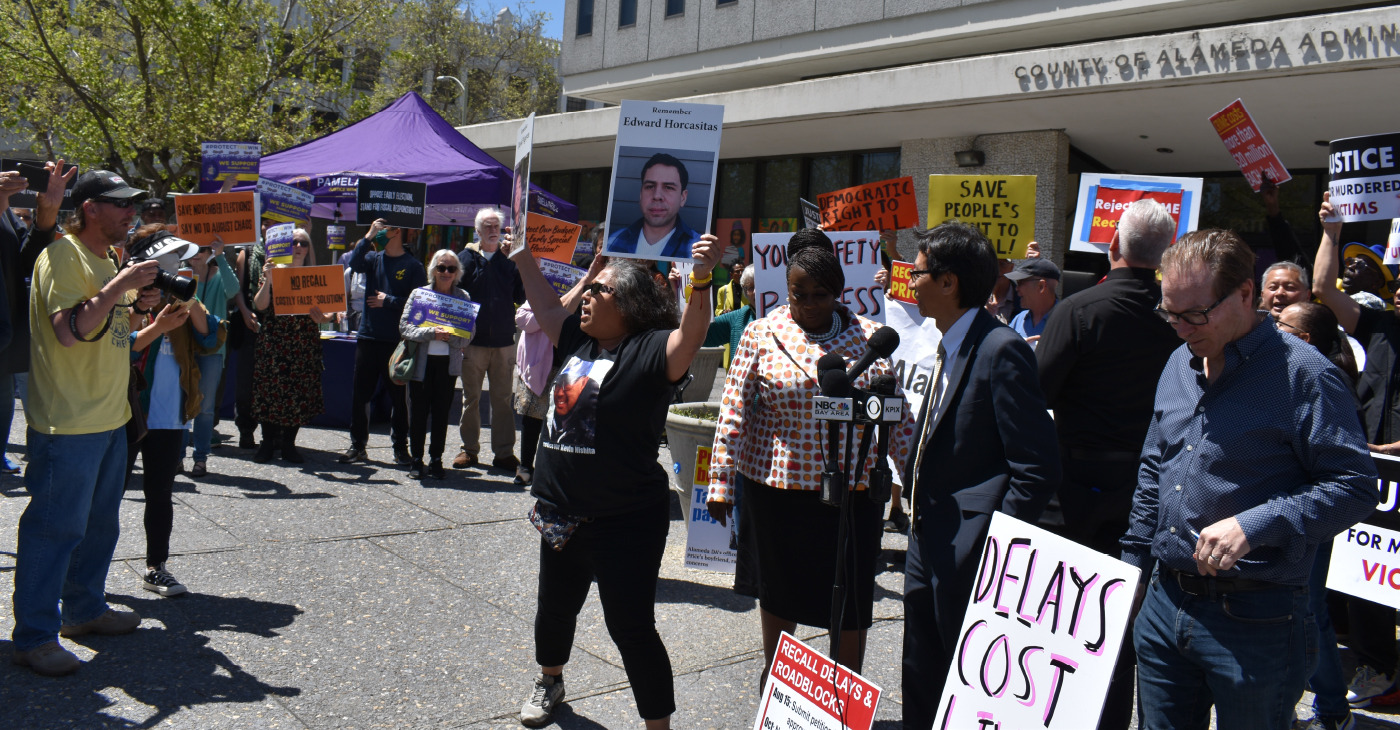
By Magaly Muñoz
The Alameda Board of Supervisors unanimously accepted the certification of the results of the valid signatures submitted for the recall of District Attorney Pamela Price on Tuesday evening. The Board will set the election date at a special meeting on May 14.
Before the meeting, recall proponents and opponents held separate press conferences to plead their cases to the Board and residents of Alameda County.
Price, who up until this point has made little public comment about the recall, held her press conference in Jack London to announce that the California Fair Political Practices Commission has opened an investigation into the finances of the Save Alameda For Everyone (SAFE) recall campaign.
The political action committee (PAC), Reviving the Bay Area, has been the largest contributor to the SAFE organization and has allegedly donated over half a million dollars to the recall efforts.
“Between September 2023 and November 2023, [Revive the Bay Area] donated approximately $578,000 to SAFE without complying with the laws that govern all political committees in California,” Price said.
Price accused the recall campaigns of using irregular signature-gathering processes, such as paying gatherers per signature, and using misleading information to get people to sign their petitions.
SAFE held their own press conference outside of the Alameda County Administration Building at 1221 Oak St. in Oakland, once again calling for the Board to certify their signatures and set a date for the recall election.
Their press conference turned contentious quickly as Price’s “Protect the Win” supporters attempted to yell over the SAFE staff and volunteers. “Stop scapegoating Price” and “Recall Price” chants went on for several moments at a time during this event.
Families of victims urged the Board to think of their loved ones whose lives are worth much more than the millions of dollars that many opponents of the recall say is too much to spend on a special election.
The Registrar of Voters (ROV) estimates the special election could cost anywhere from $15 to $20 million, an amount that is not in their budget.
The Board was presented with several options on when and how to conduct the recall election. They have to set a date no less than 88 days or more than 125 days after May 14, meaning the date could fall anywhere from late July to September.
But the County charter also states that if a general election takes place within 180 days of their scheduling deadline, the Board could choose to use the November ballot as a way to consolidate the two events.
In the event that Price is recalled, the Supervisors would appoint someone to fill the vacancy, though neither the County nor the California charter specifies how long they would have to pick a replacement.
The appointee would serve as district attorney spot until the next election in 2026. Afterwards, either they, if they run and win, or a newly elected candidate would serve the rest of Price’s six-year term until 2029. Price is unique as the only district attorney wo serves a term of six years.
The Board acknowledged that they knew last fall that this recall would come with its own set of complications when Measure B, which changed the local recall charter to match California’s, was first brought to their consideration.
Supervisors Nate Miley and David Haubert opposed discussing the measure, stating that the public would think that the Board was attempting to influence the recall campaign that had already taken off months prior.
“I think ultimately this feels like it’s going to end up in court, one way or the other, depending on who files what,” Haubert said.
Price’s legal team told the Post that the district attorney intended to consider all legal options should the recall election take place.
Miley stated that while he was in support of the amendment to the charter, he did not think it was right to schedule it for the March ballot as it would ultimately cause confusion for everyone involved.
“It has produced some legal entanglements that I think, potentially, could’ve been avoided,” Miley said.
Commentary
Opinion: Lessons for Current Student Protesters From a San Francisco State Strike Veteran
How the nation’s first College of Ethnic studies came about, bringing together Latino, African American and Asian American disciplines may offer some clues as to how to ease the current turmoil on American college campuses over the Israel-Hamas war. After the deadline passed to end the Columbia University encampment by 2 p.m. Monday, student protesters blockaded and occupied Hamilton Hall in a symbolic move early Tuesday morning. Protesters did the same in 1968.

By Emil Guillermo
How the nation’s first College of Ethnic studies came about, bringing together Latino, African American and Asian American disciplines may offer some clues as to how to ease the current turmoil on American college campuses over the Israel-Hamas war.
After the deadline passed to end the Columbia University encampment by 2 p.m. Monday, student protesters blockaded and occupied Hamilton Hall in a symbolic move early Tuesday morning.
Protesters did the same in 1968.
That made me think of San Francisco State University, 1968.
The news was filled with call backs to practically every student protest in the past six decades as arrests mounted into hundreds on nearly two dozen campuses around the country.
In 1970, the protests at Kent State were over the Vietnam War. Ohio National Guardsmen came in, opened fire, and killed four students.
Less than two weeks later that year, civil rights activists outside a dormitory at Jackson State were confronted by armed police. Two African American students were killed, twelve injured.
But again, I didn’t hear anyone mention San Francisco State University, 1968.
That protest addressed all the issues of the day and more. The student strike at SFSU was against the Vietnam war.
That final goal was eventually achieved, but there was violence, sparked mostly by “outside agitators,” who were confronted by police.
“People used the term ‘off the pigs’ but it was more rally rhetoric than a call to action (to actually kill police),” said Daniel Phil Gonzales, who was one of the strikers in 1968.
Gonzales, known as the go-to resource among Filipino American scholars for decades, went on to teach at what was the positive outcome of the strike, San Francisco State University’s College of Ethnic Studies. It’s believed to be the first of its kind in the nation. Gonzales recently retired after more than 50 years as professor.
As for today’s protests, Gonzales is dismayed that the students have constantly dealt with charges of antisemitism.
“It stymies conversation and encourages further polarization and the possibility of violent confrontation,” he said. “You’re going to be labeled pro-Hamas or pro-terrorist.”
That’s happening now. But we forget we are dealing not with Hamas proxies. We are dealing with students.
Gonzales said that was a key lesson at SF State’s strike. The main coalition driving the strike was aided by self-policing from inside of the movement. “That’s very difficult to maintain. Once you start this kind of activity, you don’t know who’s going to join,” he said.
Gonzales believes that in the current situation, there is a patch of humanity, common ground, where one can be both pro-Palestine and pro-Israel. He said it’s made difficult if you stand against the belligerent policies of Benjamin Netanyahu. In that case, you’re likely to be labeled antisemitic.
Despite that, Gonzales is in solidarity with the protesters and the people of Gaza, generally. Not Hamas. And he sees how most of the young people protesting are in shock at what he called the “duration of the absolute inhumane kind of persecution and prosecution of the Palestinians carried out by the Israeli government.”
As a survivor of campus protest decades ago, Gonzales offered some advice to the student protesters of 2024.
“You have to have a definable goal, but right now the path to that goal is unclear,” he said.
About the Author
Emil Guillermo is a journalist and commentator. A veteran newsman in TV and print, he is a former host of NPR’s “All Things Considered.”
Community
Gov. Newsom, Attorney General Bonta Back Bill to Allow California to Host Arizona Abortion Care
Gov. Gavin Newsom and Attorney General Rob Bonta announced last week that they are backing a bill introduced by the state legislative women’s caucus that would allow Arizona-based doctors to provide abortion care in California to patients from Arizona. Senate Bill (SB) 233 was authored in response to the Arizona Supreme Court’s decision on April 9 that an 1864 ban on abortion in the state is enforceable.
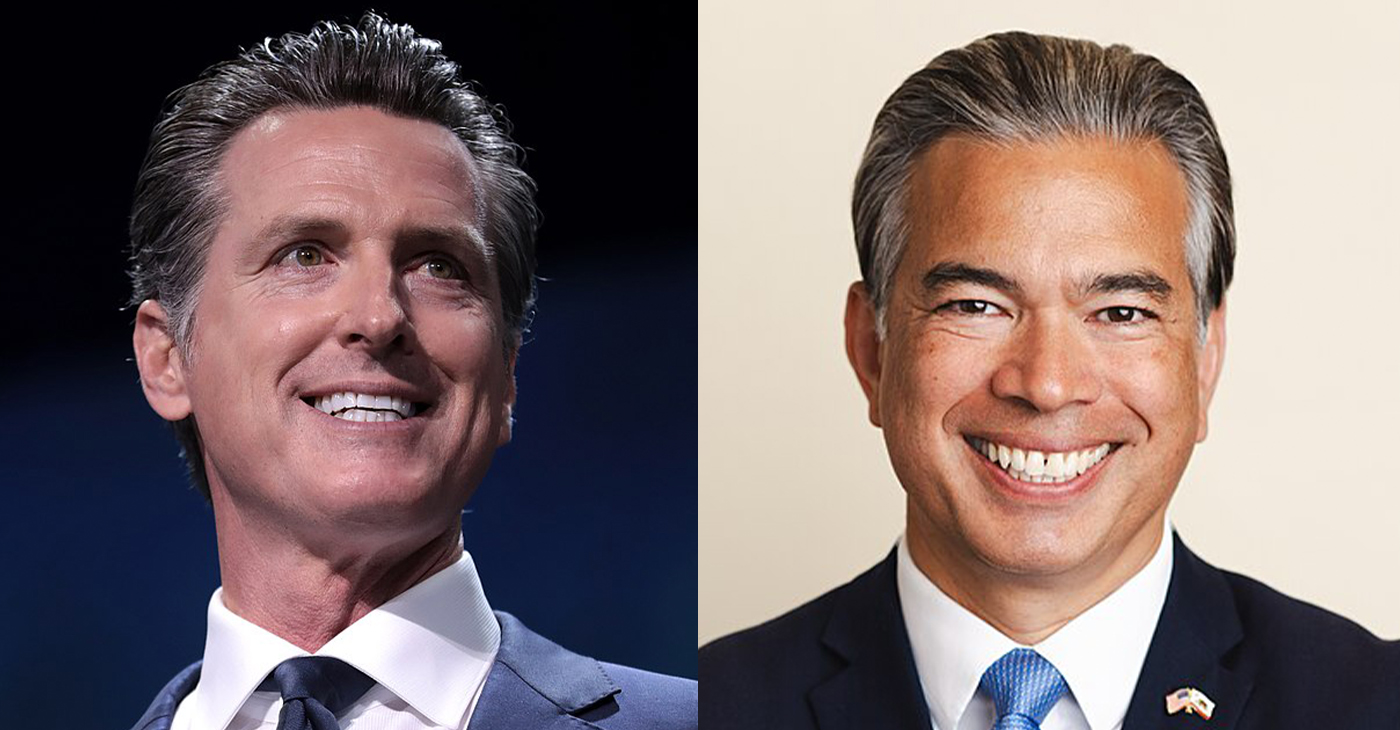
By California Black Media
Gov. Gavin Newsom and Attorney General Rob Bonta announced last week that they are backing a bill introduced by the state legislative women’s caucus that would allow Arizona-based doctors to provide abortion care in California to patients from Arizona.
Senate Bill (SB) 233 was authored in response to the Arizona Supreme Court’s decision on April 9 that an 1864 ban on abortion in the state is enforceable. The bill also aims to counter growing support for anti-abortion legislation in states with Republican-majority legislatures since Roe v. Wade was overturned, according to supporters.
“California will not sit idly by. We’re urgently moving legislation to allow Arizona doctors to provide safe and reliable reproductive care to Arizonans here in California,” Newsom said.
Sen. Nancy Skinner (D-Berkeley), chair of the California Legislative Women’s Caucus said that abortion bans are based on laws that set women back to a time when they had limited human rights.
“Anti-abortion forces have resurrected a dead law passed at a time when women couldn’t vote and husbands beating their wives was lawful,” Skinner said.
On April 24, the Arizona House of Representatives voted to repeal the 1864 abortion ban. It now moves to the Arizona Senate for deliberation.
-

 Community2 weeks ago
Community2 weeks agoFinancial Assistance Bill for Descendants of Enslaved Persons to Help Them Purchase, Own, or Maintain a Home
-

 Activism4 weeks ago
Activism4 weeks agoOakland Post: Week of April 3 – 6, 2024
-

 Business2 weeks ago
Business2 weeks agoV.P. Kamala Harris: Americans With Criminal Records Will Soon Be Eligible for SBA Loans
-

 Community2 weeks ago
Community2 weeks agoAG Bonta Says Oakland School Leaders Should Comply with State Laws to Avoid ‘Disparate Harm’ When Closing or Merging Schools
-

 Activism3 weeks ago
Activism3 weeks agoOakland Post: Week of April 10 – 16, 2024
-

 Community2 weeks ago
Community2 weeks agoOakland WNBA Player to be Inducted Into Hall of Fame
-

 Community2 weeks ago
Community2 weeks agoRichmond Nonprofit Helps Ex-Felons Get Back on Their Feet
-

 Community2 weeks ago
Community2 weeks agoRPAL to Rename Technology Center for Retired Police Captain Arthur Lee Johnson



